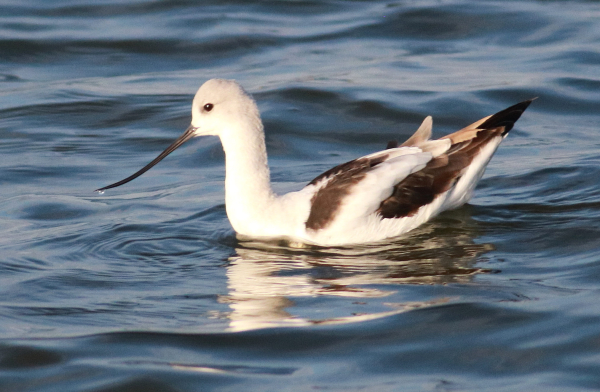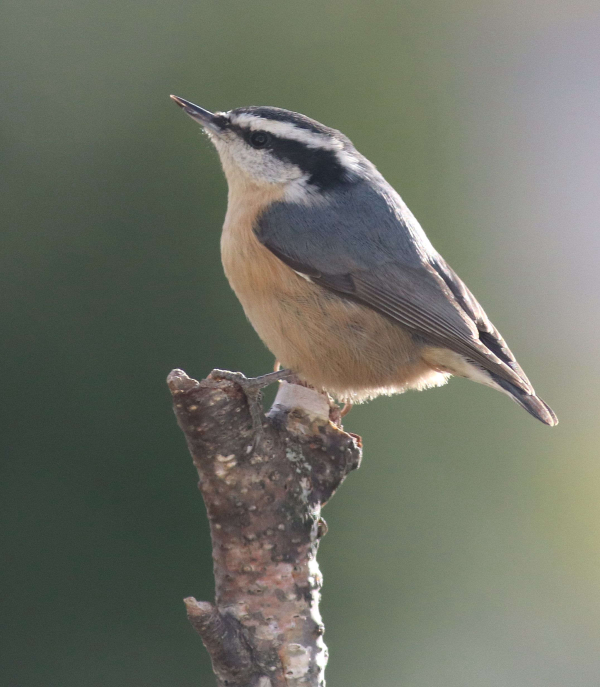
Despite windy conditions on the marsh, three American Avocets swam into deeper water to forage.

A weekend fallout of northern migrants included Red-breasted Nuthatches, Pine Siskins, Dark-eyed Juncos, Ruby-crowned Kinglets, a Brown Creeper, and a White-throated Sparrow.
|
Coincidence? I decided to start the new month by adding my seed feeder to my feeding station lineup, and within 10 minutes an active flock of Pine Siskins took over the site. It’s interesting that they mostly utilized the fresh water in my birdbath, two and three at a time, but a couple utilized the seed feeder too. Simultaneously, a Brown Creeper appeared on the lower trunk of the now-golden-leaved ash tree. That was a big indication of a morning fallout, and I hoped to see more new arrivals. Then the first Dark-eyed Juncos of the season appeared, along with a Ruby-crowned Kinglet! Hey, this is fun!
Next a Blue Jay perched at the feeders, and a couple more Pine Siskins stopped, along with another Ruby-crowned Kinglet and a White-breasted Nuthatch. None of these birds used my restaurant services, but what I assume was my regular male Downy Woodpecker spent time feeding at my suet feeder.
Saturday the first bird at my feeders was a Red-breasted Nuthatch, another bird from the northern forest. A couple Pine Siskins soon followed, along with at least 2 White-breasted Nuthatches. All these birds were feeding at the seed feeder, which I fill with a shelled mix of seeds and nuts that I prefer because it eliminates the seed hull mess around my feeding station. Other birds included a Blue Jay that drank at my bird bath, as did the siskins, and at least one Ruby-crowned Kinglet foraging in the adjacent ash tree. Finally, during the first hour a male Hairy Woodpecker was the first of its kind to feed at the seed feeder.
Later in the day I saw a young Dark-eyed Junco in the ash tree, and a surprise White-throated Sparrow fed below the feeders. A flock of Chipping Sparrows moved through the area, along with duos of American Robins and Mourning Doves. It was also fun to see White- and Red-breasted Nuthatches on the trunk of the ash tree at the same time. In short, I enjoyed a good mix of fall migrants!
Sunday was largely a rerun of the previous days, sans the White-throated Sparrow, which made me think that the Pine Siskins and Red-breasted Nuthatches were becoming the new normal, but on Monday it was evident the new migrants moved on when the strong south wind turned into a strong northwest wind. There will be more soon I’m sure, and a new seed feeder visitor was a female or immature Purple Finch, another migrant from the north.
Prairie–River Run
During the past 3 weeks I switched my practice of taking varied routes to check birdlife across 130 mile drive across the Great Plains from home to my hometown of Bismarck. Instead I’ve been driving straight west to the Missouri River, then following the river north. The broad Missouri is a major migration route that makes this travel route especially interesting week to week, and I still get a good impression of bird activities across the wetland-rich Missouri Coteau during the first hour, along with the more rugged terrain of the elevated prairie hills and buttes along the Missouri Slope.
Last Wednesday there was an abundance of Red-tailed Hawks across the entire drive, although obviously absent were Swainson’s Hawks. Usually Swainson’s begin leaving the area the last week of September, and they apparently migrated south in force, taking advantage of the strong northwest wind that dominated the previous week. Many ducks have also left, especially the previously abundant Blue-winged Teal, but there was a big drop in duck numbers overall. Franklin’s Gulls were noticeably absent and I saw very few Ring-billed Gulls. White Pelicans were notably absent, along with swallows and Killdeer, and those are just the obvious species – many prairie songbirds are also long gone.
Although Red-tails were abundant, there were no other raptor species along the way. Obviously, I was hoping for more falcons, as I experienced 2 weeks before; possibly some migrating Cooper’s and Sharp-shinned Hawks, certainly some Northern Harriers, American Kestrels, and Bald Eagles – but no luck on all fronts. Another day! I also look out for migrating Whooping Cranes, a definite possibility, although a remote one considering the extreme rarity of Whoopers, but the river is a regular migration corridor for them. The most uncommon bird I sighted was a Black-billed Magpie that floated lightly across my windshield view. Magpies are relatively common from the Missouri Breaks westward but they are rare east of the east-west line seemingly created by the Mighty Mo.
McKenzie Action
I took a bit of a side trip before heading into Bismarck to check the action at McKenzie Slough. There were still more than 100 American Avocets present, and it seemed the duck numbers were much reduced, until an adult Bald Eagle soared overhead, making big flocks of ducks flush high by the hundreds. There were a few Pied-billed Grebes present, and a small flock of Giant Canada Geese, but wading birds were obvious no-shows in the area.
Local Birding
Closer to home, fall colors in the area have peaked but are still dominant with fall harvest in full swing. During my Saturday evening drive, I had my best photo op just a half-mile south of my office, where I found 3 American Avocets feeding as they swam in Melody’s Marsh. Many small flocks of Giant Canada Geese were obvious across the sky, as were scattered Red-tailed Hawks and a few Northern Harriers. A few flocks of Gadwalls, Ruddy Ducks, and Mallards were evident with some scattered Northern Shovelers too. Numbers of American Coots abound, and there are plenty of Pied-billed Grebes around, although Western Grebes appear to have migrated. As I turned toward home, a big white bird breezed low across the sky – possibly the last White Pelican of the season.
Strong winds, whether out of the northwest or south, even the west, have dominated the past two weeks, which has not been great for field birding. But the northwest seems to have brought the new waves of birds from the north, including several first of fall species noted above. I’m kind of overdue for a really exciting birding episode, so stay tuned – I’ll fill you in when it happens! Enjoy these fine days of October.
Article and photos by Paul Konrad
Share your bird sightings and photos at editorstbw2@gmail.com